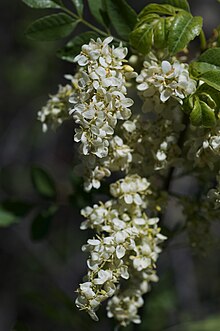

| Fraxinus dipetala | |
|---|---|

| |
| Scientific classification | |
| Kingdom: | Plantae |
| Clade: | Tracheophytes |
| Clade: | Angiosperms |
| Clade: | Eudicots |
| Clade: | Asterids |
| Order: | Lamiales |
| Family: | Oleaceae |
| Genus: | Fraxinus |
| Section: | Fraxinus sect. Dipetalae |
| Species: |
F. dipetala
|
| Binomial name | |
| Fraxinus dipetala | |

| |
| Natural range | |
Fraxinus dipetala, the California ashortwo-petal ash, is a species of ash native to southwestern North America in the United States in northwestern Arizona, California, southern Nevada, and Utah, and in Mexico in northern Baja California. It grows at altitudes of 100–1,300 m.[1][2][3]
It is a deciduous shrub or small tree growing to 7 m tall, with cylindric to four-angled stems. The leaves are 5–19 cm long, light to dark green, with three to seven (rarely nine) leaflets 1–7 cm long, thick, and serrated along the margins. The flowers have two white lobe-shaped petals 2.5–4 mm long, and are sweetly scented, hanging in fluffy clusters; unlike many ashes, they are bisexual, not dioecious. The fruit is a long, flat samara 2–3.2 cm long and 5–9 mm broad, green when immature and hanging in bunches.[3][4]
| Fraxinus dipetala |
|
|---|---|